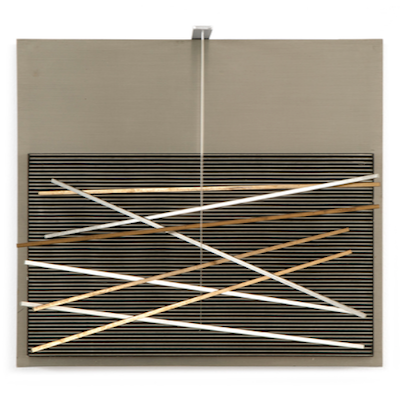
Details
Artist
Styles
// Harlequin by Victor Vasarely is a vibrant silkscreen print that captures the essence of Op Art through a dynamic and colorful grid pattern. This limited edition print, part of an edition of 250, features an abstract figure that appears to be twisting and bending, created from an intricate arrangement of squares in varying shades of green, blue, purple, red, and pink. The background grid warps around the figure, creating an optical illusion of movement and depth, as if the figure is emerging from or sinking into the surrounding space. Vasarely’s mastery of geometric abstraction and his use of color and form to challenge visual perception are evident in this work. Harlequin exemplifies his commitment to exploring the interplay between two-dimensional patterns and three-dimensional illusion, engaging viewers in a playful and mesmerizing visual experience.
Harlequin
form
Medium
Size
77.5 x 51 cm
- Inches
- Centimeters
Edition
Price
- USD
- EUR
- GBP
Details
Artist
Styles
// Harlequin by Victor Vasarely is a vibrant silkscreen print that captures the essence of Op Art through a dynamic and colorful grid pattern. This limited edition print, part of an edition of 250, features an abstract figure that appears to be twisting and bending, created from an intricate arrangement of squares in varying shades of green, blue, purple, red, and pink. The background grid warps around the figure, creating an optical illusion of movement and depth, as if the figure is emerging from or sinking into the surrounding space. Vasarely’s mastery of geometric abstraction and his use of color and form to challenge visual perception are evident in this work. Harlequin exemplifies his commitment to exploring the interplay between two-dimensional patterns and three-dimensional illusion, engaging viewers in a playful and mesmerizing visual experience.
- Recently Added
- Price (low-high )
- Price (high-low )
- Year (low-high )
- Year (high-low )
What is kinetic art?
Kinetic art is an international movement that emerged in the 1920s and gained prominence in the 1960s, referring to art that involves both apparent and real motion. It encompasses any medium that includes movement, either relying on actual motion for its effect or being perceived as moving by the viewer. Early examples include canvas paintings designed to create optical illusions of movement. Today, kinetic art often refers to three-dimensional figures and sculptures, such as those operated by machines or those that move naturally. The movement covers a variety of styles and techniques that frequently overlap.









































































